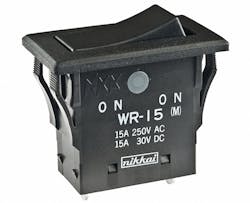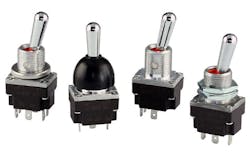Alternating current (ac) or direct current (dc) circuits are capable of carrying very different currents, as illustrated by the ratings on the switch in Figure 1. This is why it’s so important for designers and engineers to understand how to pick the right switch for their product.
1. The ratings on this switch illustrate the significant differences between ac and dc voltage ratings, for the same current rating.
Switching Speed
While there’s an enormous variety of switches available, they mostly all do the same thing: Turn power to an electrical circuit on or off by making or breaking an electrical connection. But it’s how they do it that’s important. How quickly the circuit needs to be broken depends on whether you’re working with ac or dc.
With dc, you’ve got a steady current in one direction, whereas with ac, both the magnitude and direction of the current change.
Imagine you have two circuits, each carrying the same current—one is an ac circuit and the other is a dc circuit. When you switch off power to an ac circuit, a voltage spark (or arc) is created inside the switch that’s quickly extinguished—a desirable condition. This is because an ac sine wave is naturally at zero amps twice per cycle. So, there’s a 50% chance that the power to the circuit will not be at peak levels when the power is switched off.
However, this isn’t the case in a dc circuit, where both the current and voltage are constant. When power is switched off to a dc circuit, it can take much longer for the voltage arc inside the switch to extinguish itself. This is why the switching speed (how fast the switch contacts open and close) of a switch in a dc circuit is so important. The objective is for the switch contacts to separate as fast as possible when turning off power to the circuit. This helps minimize the arc’s time to develop and extinguish itself.
The longer a switch takes to open or break the power to the circuit, the more prolonged the arc. This can result in the switch contacts becoming pitted, potentially lead to overheating, premature switch failure, or even a fire.
Know your Load Type
As well as the speed at which the switch works, the nature of the electrical load is important in determining whether a switch will be suitable. Will it be switching an inductive or resistive load? This will affect both the voltages and currents your switch has to deal with.
Take a resistive (R) load, such as a heater or a traditional incandescent light bulb. With these sorts of loads, when you turn the circuit on, your current rises immediately to its steady state, without first exceeding this level. Meanwhile, the voltage for the most part remains steady.
Conversely, an inductive (L) load, such as a transformer or electric motor, will initially draw a large amount of "inrush current" when first switched on before settling back down after a few seconds to the load’s full running current. Also, when an inductive load is switched off, a huge voltage develops across the switches’ contacts in the form of an arc. This arc voltage can be much higher than what the switch is rated for, which can lead to contact pitting and shorten the switch’s life.
These peak fluctuations in current and voltage are important when choosing your switch. If the electrical ratings aren’t suitable, either your switch will fail immediately, or you will considerably shorten the life of the switch.
For the same current rating, the dc voltage rating on a switch will generally be much lower than its ac voltage rating. For example, a switch rated for 15 A at 250 Vac will only be rated for 15 A at 12 Vdc. The only difference is whether you are dealing with ac or dc.
Choose a Certified Switch
While there will doubtless be numerous suitable switches for your application (Fig. 2), it’s always best to choose one that’s been certified to a recognized standard. This will ensure it performs—both electrically and mechanically—the way it’s intended. Two important standards bodies in this regard are the Underwriters Laboratories (UL), and Verband der Elektrotechnik, Elektronik und Informationstechnik (VDE).
2. Switches come in numerous styles.
The UL provides a range of services to manufacturers, retailers, consumers, and service companies, as well as to policymakers and regulators. Its offerings include safety certification, testing, validation, inspection, and audit. It also has a variety of training and advisory services.
The VDE, which translates as the Association for Electrical, Electronic and Information Technologies, is one of Europe’s biggest scientific and technical organizations.
For the certification or recognition to be valid, the approving agency’s logo or marking will usually appear somewhere on the switch’s body or as a designator at the end of the switch’s part number.
Making the Right Choice
So, to recap, are you creating an ac or dc circuit? And is the load that you’re switching inductive or resistive? Answering these two key questions will help you pick the right switch for your design.
Rudy Ramos is Project Manager - Technical Content Marketing at Mouser Electronics.



